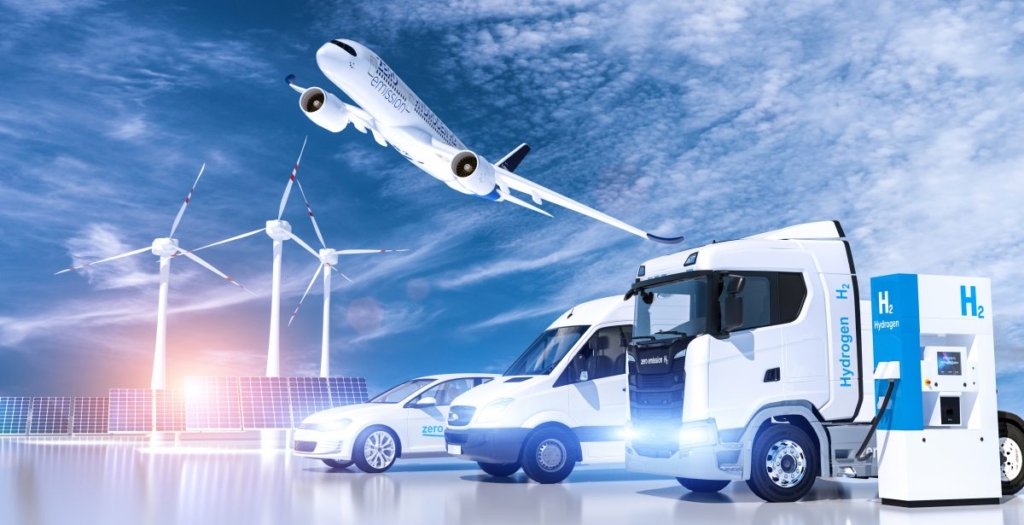
Types of Carbon Fibre Pressure Vessels
Carbon fibre pressure vessels offer a competitive solution to liquid and gas storage needs at higher pressure and with less weight than traditional steel pressure vessels. Pressure vessels like these will only become more important as the world moves to a more sustainable future; the weight benefits are key to transitioning vehicles from fossil fuels to hydrogen fuel.
There are five types of pressure vessels: type one, type two, type 3, type 4, and type 5. Each type has a different construction.
Type one pressure vessels are entirely made from metal, relying on it to hold all the pressure and fully seal the vessel.
Type two pressure vessels are an evolution of type one pressure vessels, with a composite, normally glass, wound around the circumference (the hoop direction) of the metal vessel to increase its strength. This means that a type two pressure vessel can be made lighter than a type one vessel rated to the same pressure and volume, while understandably increasing costs.
Type three pressure vessels are further evolution of type two pressure vessels, relying more so on the composite overwrap than a type two vessel. These involve fully wrapping the metal vessel with the carbon fibre filament in a specific pattern so that the force exerted by pressurised fluid is resisted by the carbon fibre overwrap in both the hoop and longitudinal directions.
Type four pressure vessels are a more radical departure from type one, two, and three pressure vessels, in that the carbon fibre is solely relied upon to withstand the pressure of the contained fluid. A thin plastic liner is used to seal the vessel, preventing any fluid from escaping through small fissures in the resin between carbon fibre filaments. The liner also provides added chemical resistance compared to metal type one, two, and three vessels.
Type five pressure vessels do away with the internal liner, instead relying on the carbon fibre filaments and the resin matrix to seal the pressure vessel. A type V pressure vessel was used on a student-built satellite in 2012, but type five pressure vessels are not yet readily used. They are not yet readily available, so is difficult to determine their cost premium over a type four pressure vessel. Nonetheless, they provide further weight savings over a type four pressure vessel, with the potential for a 20% weight-saving.
How durable and reliable are carbon fibre pressure vessels?
Fully overwrapped vessels are significantly more durable than type one and two pressure vessels, with lifespans up to 30 years for some type IV pressure vessels. Their durability was exemplified by a SpaceX carbon fibre over wrapped pressure vessel, which survived re-entry from orbit and landed largely intact in a farm in Washington, USA.
Hydrogen pressure vessels are subject to the added issue of hydrogen embrittlement. Hydrogen embrittlement is a process by which metals under stress become brittle through prolonged contact with hydrogen, like in pressure vessels, which are necessarily under stress and in contact with their fluid. This makes it more likely for the metal to fracture and compromise the integrity of the vessel. For this reason, choosing an appropriate pressure vessel for storing hydrogen is vital.
Certain grades of steel are less prone to hydrogen embrittlement, and some manufacturing techniques can protect the metal. With this in mind, type three, four, and five composite pressure vessels are very well suited to storing hydrogen owing to their lack of metal liner.
Pressure vessels used in transport are regulated in many countries, requiring burst tests, impact testing, and pressure cycling. Once in service, they can require periodic testing and visual inspection. Hydrogen pressure vessels specifically require additional leak testing, bullet testing, and flame testing, where the pressure vessel is exposed to a fire.
This vital testing is to ensure the safety of anybody in the vicinity of a pressure vessel under high pressure, as while failures can occur slowly through leaks, failures can also occur catastrophically. Nonetheless, any failure of a pressure vessel can pose a safety risk when the fluid is inflammable or otherwise harmful to people.
What uses are there for carbon fibre pressure vessels in transportation?
Carbon fibre pressures vessels, with their significant weight savings over standard metal pressure vessels, are an attractive choice for use in transportation, where every extra kilogram on the vehicle costs money. Carbon fibre pressure vessels are vital to the strides towards sustainability in transport on land and in the air.
Land
Carbon fibre pressure vessels for hydrogen storage in road vehicles are becoming an increasingly popular choice, as it becomes clearer that not all vehicle electrification can rely on large and heavy battery packs. Hyundai has chosen carbon fibre pressure vessels to store hydrogen for its NEXO hydrogen fuel cell powered car.
First Bus and Aberdeen City Council have introduced the world’s first hydrogen powered double decker bus, again relying on carbon fibre pressure vessels for the hydrogen storage. A number of companies are also working on carbon fibre pressure vessels for use in hydrogen trucks and hydrogen lorries, including Hyundai, which is using the same technology used in its NEXO car on its new line of hydrogen fuel cell powered trucks.
Hydrogen powered trains are also coming on stream, expected to replace diesel-powered trains where full electrification of the train lines is not economical. Alstom’s Coradia iLint trains were the first hydrogen-powered trains to enter service, with further trials taking place in Austria, Poland, The Netherlands, and Sweden. The prototype vehicles used carbon fibre pressure vessels for hydrogen storage made by Hexagon Xperion, now Hexagon Purus.
Hexagon Purus itself has been chosen by Spanish train manufacturer Talgo to supply type 4 pressure vessels for its first hydrogen trains. Interest in hydrogen trains is increasing rapidly, with trials and pilot projects taking place across the globe, including China and Japan, which are famed for their railway systems.
Air
As attention is moving towards the decarbonisation of planes, it is becoming increasingly clear that the immense weight of the batteries that would be required for an electric long-range airliner is prohibitive. Hydrogen provides a much more efficient solution to low weight energy storage. It is for this reason, that Airbus is aiming to have a hydrogen-powered airliner in service by 2035.
While hydrogen is well suited from an energy to weight perspective, it presents some challenges from an energy to volume perspective. For this reason, it is vital to store the hydrogen in the most volume dense manner possible, which means at very high pressure, or cryogenically as a liquid.
Given the difficulties and technical complexity required in keeping hydrogen at a sufficiently low temperature to remain liquid, high pressure gaseous hydrogen is the key to using hydrogen in planes. A fantastic example of this in is Universal Hydrogen’s modular hydrogen fuel capsules, which will enter flight testing in 2022. These type 4 carbon fibre pressure vessels are an example of the vital role that carbon fibre pressure vessels will pay in the coming decades.
SageZander supplies Tairyfil carbon fibre filament, including
the new Tc-780 grade, developed with a specific focus on pressure vessels,
including for hydrogen. For more information on this grade and all other grades
of carbon fibre that SageZander can supply, please refer to our carbon fibre page. For sales
enquiries, please us on +44 (0)1260 295264, or email sales@sagezander.com.


